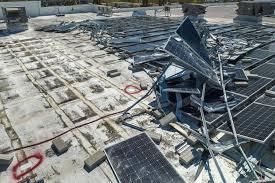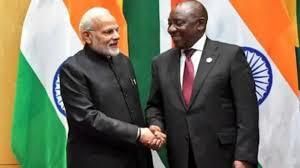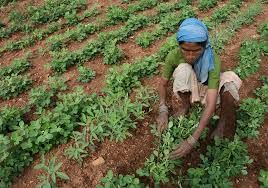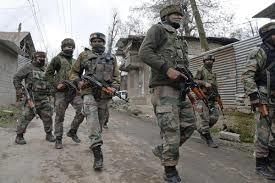Weekly Current Affairs (1st to 7th April 2024) Part - 2 | General Test Preparation for CUET UG - CUET Commerce PDF Download
| Table of contents |

|
| Solar Waste Management |

|
| Africa at Centre of India’s Vision for Global South |

|
| Accelerating Crop Diversification in India |

|
| Armed Forces (Special Powers) Act, 1958 (AFSPA) |

|
Solar Waste Management
Context: In recent news, a report titled 'Enabling a Circular Economy in India’s Solar Industry – Assessing the Solar Waste Quantum' has brought attention to India's burgeoning solar waste crisis. This study, conducted by the Ministry of New and Renewable Energy (MNRE) in collaboration with experts from the Council on Energy, Environment and Water, a prominent not-for-profit policy research institution in Asia, highlights several key insights.
Key Highlights of the Report:
- Solar Waste Projection: As of FY23, India's current solar capacity has generated approximately 100 kilotonnes (kt) of cumulative waste, projected to increase to 340 kt by 2030. This volume is anticipated to surge 32 times by 2050, resulting in about 19,000 kt of cumulative waste, with 77% attributed to new capacities.
- State-wise Contribution: It is projected that around 67% of the waste generated by 2030 will originate from five states: Rajasthan, Gujarat, Karnataka, Tamil Nadu, and Andhra Pradesh. Rajasthan is expected to account for 24% of the waste by 2030, followed by Gujarat (16%) and Karnataka (12%).
- Critical Minerals Content: Discarded solar modules contain critical minerals crucial for India's economic development and national security, including silicon, copper, tellurium, and cadmium. The projected 340 kt of waste by 2030 is estimated to contain 10 kt of silicon, 12-18 tonnes of silver, and 16 tonnes of cadmium and tellurium.
Recommendations:
- The MNRE is urged to maintain and periodically update a database of installed solar capacity, containing details such as module technology, manufacturer, commissioning date, etc., to facilitate accurate mapping of plausible waste generation centers.
- The Ministry of Environment, Forest and Climate Change should issue guidelines for the collection and storage of solar waste and promote its safe and efficient processing.
- Solar cell and module producers are encouraged to establish waste collection and storage centers to fulfill their responsibilities as outlined in the Electronic Waste Management Rules 2022.
What is Solar Waste?
- About: Solar waste is any waste generated during the manufacturing of solar modules, or discarded modules and scrap from manufacturing processes.
- Modules are discarded at the end of their functional life or due to damages from transportation, handling, and installation.
- Improper handling and landfilling of solar waste should be avoided. Proper treatment is necessary to reclaim valuable minerals and prevent the leaching of toxic materials like lead and cadmium.
- Potential Recyclability of Solar Waste: Approximately 80% of solar panel components, including glass and metal frames, are recyclable, according to the International Renewable Energy Agency (IRENA).
- Solar waste can be recycled to recover materials like glass, aluminium, copper, silicon and silver.
- Recycling can be broadly categorised into mechanical, thermal and chemical processes.
- Each process helps in the recovery of specific minerals of varying purity grades.
Challenges of Solar Waste Recycling in India:
- Lack of Policy Framework: The absence of specific comprehensive laws governing solar waste management hinders the establishment of standardised recycling practices and may contribute to inconsistent recycling efforts.
- Complex Composition & Difficulty in Separation: Solar panels contain various materials like silicon, glass, aluminium, and toxic elements like lead and cadmium.
- Separating these components for effective recycling requires specialised technology, which is often expensive and not widely available in India.
- Informal Sector Involvement: A large portion of solar waste ends up with informal recyclers who lack proper safety measures and often resort to environmentally harmful practices.
- Limited Market for Recycled Materials: In India, lack of adequate demand for materials such as silicon wafers or glass cullet from recycled panels undermines the economic feasibility of recycling efforts.
Managing solar waste effectively in India requires several strategic measures:
- Establishment of a Stringent Regulatory Framework: India can develop a comprehensive regulatory framework to govern the collection, recycling, and attainment of material-specific recovery targets for solar waste. This framework should incentivize recycling and mineral recovery through mechanisms like green certificates. Additionally, it should encompass policies promoting circular economy principles within the solar industry, encouraging resource efficiency, recycling, and reuse.
- Formalization of Informal Recyclers: Integrating informal recyclers into the formal system via training programs and provision of appropriate equipment is crucial. This ensures adherence to safe, environmentally sound practices while also providing these workers with secure employment opportunities.
- Promotion of Solar Panel Refurbishment and Second Life: Establishing dedicated refurbishment facilities enables the cleaning, repair, and retesting of slightly damaged solar panels, diverting them from the waste stream and offering affordable options for consumers.
- Encouragement of Solar-Waste Entrepreneurship: India can incentivize and promote green innovators to develop new sustainable products using recycled solar materials. This approach fosters creativity and effective utilization of resources while contributing to environmental sustainability.
Africa at Centre of India’s Vision for Global South
Context: India's heightened engagement with Africa has been prominently featured during various state visits, underscoring a notable shift that reflects India's emerging prominence as a significant global power. This emphasis presents an opportunity for India to champion the interests of the Global South.
India’s Vision for the Global South:
- Advocating for the Global South: India positions itself as a spokesperson for developing nations, ensuring their concerns are articulated on platforms such as the G20. Initiatives like the "Voice of Global South Summit" aim to provide a forum for developing countries to address shared challenges.
- Advocacy and Reform: India advocates for reforms in global institutions to better represent the interests of developing nations. This may involve reforms in areas such as international taxation, climate finance, or enhancing the decision-making power of developing nations within organizations like the United Nations Security Council.
- South-South Cooperation: India promotes collaboration among developing countries by sharing best practices, technologies, and resources. The India-UN Development Partnership Fund, established in 2017, supports Southern-led sustainable development projects, with a focus on least developed countries and small island developing states.
- Climate Change Mitigation: India's vision for the Global South includes collaborative efforts to combat climate change. Initiatives like the International Solar Alliance (ISA) aim to encourage the adoption of renewable energy in countries across Asia, Africa, and Latin America, contributing to sustainable development and climate resilience.
How can India Benefit from Prioritising Africa in its Global South Vision?
- Economic Potential: Africa represents a vast economic opportunity for India. With Indian investments in Africa reaching USD 98 billion in 2023 and trade totaling USD 100 billion, the continent serves as a crucial market for Indian businesses.
- Enhanced Strategic Ties: Africa's influence in global forums is rising, making it a strategic partner for India's global aspirations.
- India's advocacy for African representation in forums like the G20 and UNSC reflects the shared vision for inclusive global governance.
- In this regard, India has achieved several diplomatic victories, such as the African Union’s (AU) inclusion in the G20 in September 2023.
- Tapping Youthful Demographics: Africa's young population, with 60% under the age of 25 years, presents immense potential for collaboration in education, technology, and innovation.
- India's experience in skill development and education initiatives can be leveraged to empower African youth and foster sustainable development.
- Potential Resource Collaboration: Africa's rich reserves of critical minerals essential for industries like renewable energy and technology offer a significant opportunity for collaboration.
- India's expertise in sectors like renewable energy can be combined with Africa's resources to drive innovation and sustainable development.
- Stronger Geopolitical Influence: A strong partnership with Africa enhances India's strategic standing on the world stage.
- It allows India to play a more influential role in shaping global governance and addressing issues critical to the Global South.
- India's growing ties with Africa can help counterbalance China's rising influence on the continent (especially in the Horn of Africa).
What are the Challenges for India as a Leader in the Global South?
- Internal Development Issues: Critics argue India should prioritise its domestic development issues like unequal wealth distribution, unemployment, and inadequate infrastructure, before leading others.
- India's vast rural population lacks access to quality healthcare and education, raising questions about its capacity to address similar issues in other developing nations.
- Diverse Needs and Priorities: The Global South is not a homogenous group. Different countries have varying needs and priorities. Balancing these diverse demands can be difficult.
- African nations might prioritise debt relief, while Southeast Asian nations might focus on technology transfer.
- India needs to find ways to address these distinct needs while promoting a unified front.
- Balancing Global Partnerships: India enjoys strong economic ties with developed nations like the US and Japan. This can create a conflict between advocating for the Global South and maintaining these vital relationships.
- India might shy away from pushing for stricter trade regulations that could potentially harm its exports to developed countries.
- Credibility on Climate Change: India is the world's third-largest emitter of CO2, despite low per capita CO2 emissions. This weakens its position when advocating for stricter climate action within the Global South.
Way Forward
- Frugal Tech Innovation: India can capitalize on its expertise in frugal innovation by establishing labs dedicated to developing low-cost, scalable technological solutions for common challenges in the Global South, such as mobile health diagnostics or remote learning platforms.
- Rotating Leadership: Instead of a single leader, India could advocate for a rotating leadership council comprising representatives from different regions within the Global South. This approach fosters collaboration and inclusivity, allowing for diverse perspectives and solutions.
- Global South Satellite Network: India can take the lead in developing a network of low-cost satellites launched and operated by a consortium of developing nations. This network can provide essential data and services for regions lacking traditional infrastructure and internet facilities. Additionally, advanced satellite technology like RISAT can be utilized to establish a rapid disaster response network within the Global South.
- South-South Vocational Training Centers: Establishing vocational training centers in strategic locations across the Global South can provide skill development programs tailored to local needs. This equips individuals with the skills required to thrive in the job market and contribute to their economies.
Accelerating Crop Diversification in India
Context: Recent reports have spotlighted a notable transformation in West Bengal's agricultural landscape, particularly in districts bordering Bangladesh, where crop diversification is gaining momentum.
- This shift entails a departure from traditional wheat cultivation towards alternative crops such as bananas, lentils, maize, and others.
Reasons Behind the Shift from Wheat Production:
- Wheat Blast Disease: The outbreak of wheat blast disease in Bangladesh in 2016 prompted a two-year ban on wheat cultivation in border regions of West Bengal, including Murshidabad and Nadia districts. This compelled farmers to explore alternative crops due to the disease's detrimental impact on wheat crops.
- Economic Viability: Farmers have cited the economic benefits of cultivating alternative crops like bananas. The profitability of bananas during peak seasons, combined with stagnant wheat prices and concerns regarding water consumption, has contributed to this shift.
- Shift to Higher Output Crops: Maize cultivation has witnessed a significant increase in the area, with production soaring eightfold from 2011 to 2023. Despite lower maize prices per quintal compared to wheat, the higher per-hectare output and demand from poultry and food processing industries make it an attractive alternative. Additionally, pulses and oilseeds production has surged in the region.
Why India Needs to Focus on Crop Diversification?
- About: Crop diversification refers to the practice of growing a variety of crops on a farm instead of focusing on a single crop.
- The Green Revolution in India, through the introduction of high-yielding rice and wheat varieties, resulted in a substantial increase in food output, effectively reducing hunger and malnutrition.
- However, the monoculture of these crops led to a decrease in crop variety, causing the decline of traditional, region-specific strains and a loss of genetic diversity.
- For instance, India has lost over 100,000 traditional rice varieties since the 1970s due to the Green Revolution's impact.
- Therefore, there is a need to shift towards crop diversification to promote sustainable agriculture.
Benefits of Crop Diversification:
- Risk Reduction: In regions prone to drought, farmers can diversify their crops by growing both drought-tolerant varieties (like millets or sorghum) and water-intensive crops (like rice or vegetables).
- If there's a water shortage, the drought-tolerant crops can still thrive, ensuring some level of harvest despite adverse conditions.
- Soil Health Improvement: Planting leguminous crops like soybeans or peanuts can fix nitrogen in the soil, benefiting subsequent crops such as maize or wheat that require nitrogen-rich soil for optimal growth.
- Market Opportunities: Diversifying crops can help farmers tap into niche markets or emerging trends.
- For example, the rising demand for organic produce presents an opportunity for farmers to diversify into organic farming, which often commands higher prices in the market compared to conventionally grown crops.
- Pest and Disease Management: Intercropping or mixed cropping, a form of crop diversification, can help manage pests and diseases.
- For instance, planting marigold flowers alongside vegetable crops can deter pests, reducing the need for chemical pesticides and promoting natural pest control mechanisms.
- Source of Biofuels: Crops like Jatropha and Pongamia are potential sources for biofuel production. This can offer farmers additional income opportunities and contribute to India's energy security.
Concerns:
- Market Risks and Limited Opportunities: Farmers are often hesitant to switch from established crops like rice and wheat (which have assured government support through MSP) to lesser-known crops.
- These alternatives may have fluctuating market prices or limited demand, leading to potential income loss.
- Financial Constraints: Diversifying crops can require additional investment in seeds, equipment, and even acquiring new knowledge about cultivation practices.
- Smallholder farmers, who make up a significant portion of India's agricultural sector, may not have the financial resources to readily adopt these changes.
- Also, Millets like Jowar, Ragi, and Bajra are gaining traction due to their high nutritional value and ability to thrive in marginal lands.
- However, creating a robust market for these requires investment in processing facilities to convert them into consumer-friendly products like ready-to-eat mixes or breakfast cereals.
- Lack of Infrastructure and Storage: Perishable, diversified crops often require specialised storage and transportation facilities that may not be readily available in rural areas.
- Without proper infrastructure, these crops can spoil quickly, leading to wasted produce and lost income.
- Clash With Dietary Habits: Crop diversification in India, particularly in regions where rice and wheat are staples for a significant portion of the population, could potentially disrupt the established market dynamics and consumption patterns prevalent in these areas.
Way Forward
- Agri-Tourism and 'U-Pick' Farms: Experiential tourism is gaining popularity. Creating 'U-Pick' farms where tourists can harvest their fruits and vegetables directly from the field can be a win-win for India.
- This provides farmers with additional income, fosters a connection between consumers and agriculture, and promotes appreciation for diversified crops.
- Biofortification through Gene Editing: Gene editing techniques like CRISPR can be used to develop crops with enhanced nutritional value.
- This can address malnutrition concerns and create new markets for biofortified crops.
- However, ethical considerations and stringent regulations need to be addressed.
- Regenerative Agriculture for Sustainable Diversification: Regenerative agriculture practices like cover cropping, composting, and no-till farming can be integrated with diversified crop rotations to create a more sustainable and resilient agricultural system.
- This not only benefits long-term crop yields but also sequesters carbon, mitigating climate change.
Armed Forces (Special Powers) Act, 1958 (AFSPA)
Context: Recent news highlights the Union Ministry of Home Affairs (MHA) extending the Armed Forces (Special Powers) Act, 1958 in parts of Nagaland and Arunachal Pradesh for an additional six months.
- In Nagaland, the AFSPA extension encompasses eight districts and 21 police stations, while in Arunachal Pradesh, it applies to specific areas.
What is AFSPA?
Background:
- The origins of the Armed Forces Special Powers Act (AFSPA) trace back to the British colonial government's Armed Forces Special Powers Ordinance of August 15, 1942, aimed at suppressing the Quit India movement. Subsequently, it evolved into legislation like the Armed Forces (Assam and Manipur) Special Powers Act, 1958, to address internal security challenges, particularly in the North-eastern states.
About:
- The AFSPA, passed by Parliament and approved by the President on September 11, 1958, grants extensive powers to the armed forces and Central Armed Police Forces deployed in designated "disturbed areas." It allows for actions such as killing, arrest, and search without a warrant, and provides immunity from prosecution without the Central government's sanction.
- The Act was enacted against the backdrop of escalating violence in the North-eastern states, which posed challenges for the respective state governments in maintaining control.
- Notifications regarding the application of AFSPA can be issued by both the state and Union governments. For Arunachal Pradesh and Nagaland, the MHA periodically issues "disturbed area" notifications, allowing for the implementation of AFSPA.
What are the Disturbed Areas described uncer AFSPA?
- A disturbed area is one that is declared by notification under Section 3 of the AFSPA. It can be invoked in places where the use of armed forces in aid of civil power is necessary.
- The Act was amended in 1972 and the powers to declare an area as “disturbed” were conferred concurrently upon the Central government along with the States.
- An area can be disturbed due to differences or disputes between members of different religious, racial, language or regional groups or castes or communities.
- The Central Government, or the Governor of the State or administrator of the Union Territory can declare the whole or part of the State or Union Territory as a disturbed area.
- Once declared ‘disturbed’, the region is maintained as disturbed for a period of three months straight, according to The Disturbed Areas (Special Courts) Act, 1976. The government of the state can suggest whether the Act is required in the state or not.
- Currently, the Union Home Ministry issues periodic “disturbed area” notification to extend AFSPA only for Nagaland and Arunachal Pradesh.
What are the Arguments in Favour and Against of AFSPA?
Argument in Favour:
- Addressing Ongoing Security Challenges: The AFSPA is deemed necessary to tackle the persistent security threats in the regions where it's enforced.
- The presence of armed groups and insurgent activities poses a continuous danger to public safety and stability.
- Without the legal framework provided by AFSPA, it might be difficult for security forces to effectively counter these threats.
- Empowering Security Forces: AFSPA provides security forces with the legal authority required to combat insurgency and terrorism effectively.
- It grants them the necessary powers to conduct operations, make arrests, and maintain public order in areas designated as disturbed.
- This empowerment is crucial for enabling security forces to tackle complex security challenges efficiently.
- Legal Protections for Personnel: AFSPA offers legal protections to security personnel operating in disturbed areas.
- These protections shield them from legal liability while they carry out their duties under challenging and often hazardous circumstances.
- Such legal safeguards are essential for ensuring that security personnel can perform their tasks without fear of undue legal consequences.
- Boosting Morale: The legal protections provided by AFSPA are instrumental in boosting the morale of armed forces personnel.
- Knowing that they are legally protected while carrying out their responsibilities can enhance their confidence and motivation to perform effectively in challenging environments.
- This morale boost is crucial for maintaining the effectiveness and efficiency of security operations in troubled regions.
Argument Against:
- Violation of State's Autonomy: Section 3 of AFSPA grants the central government the authority to designate any area as a Disturbed Area without requiring the consent of the respective state.
- This undermines the autonomy of the states and can lead to misuse of power by the central government.
- Excessive Use of Force: Section 4 of AFSPA grants specific powers to authorized officers, including the use of firearms against individuals, which can potentially result in fatalities.
- This provision raises concerns about the excessive and disproportionate use of force by security forces.
- Violation of Civil Liberties: Section 4 also grants officers the power to arrest without a warrant and to seize and search premises without any warrant.
- This can lead to violations of individuals' civil liberties, as it bypasses standard legal procedures and safeguards against arbitrary detention and searches.
- Lack of Accountability: Section 7 of AFSPA requires obtaining prior executive approval from central or state authorities for the prosecution of a member of the security forces.
- This provision creates a lack of accountability and transparency in cases of alleged human rights violations by security forces, as it allows them to operate with impunity.
- Evidence of Abuse: The Supreme Court-appointed Hegde Commission in 2013 found that all seven deaths in the six cases it investigated were extrajudicial executions.
- Additionally, it highlighted widespread abuse of AFSPA by security forces in Manipur.
What are the Supreme Court’s Guidelines?
- Queries regarding the constitutionality of AFSPA emerged due to its intersection with the jurisdiction of states over law and order matters. In its landmark 1998 judgment in Naga People's Movement of Human Rights v. Union of India, the Supreme Court upheld the constitutionality of AFSPA. The Court's ruling entailed specific conclusions:
- Authority for Declaration: While the Central government possesses the authority to make a suo-motto declaration, it is advisable for the central government to consult with the state government before such a declaration.
- Limitations on Designation: AFSPA does not confer unrestricted authority to designate an area as a 'disturbed area.' The declaration must have a defined time frame, and there should be periodic assessments of its status, with a mandatory review after six months.
- Use of Force: When exercising the powers granted by AFSPA, the authorized officer must employ the minimum necessary force for successful operations and strictly adhere to the guidelines outlined in the army's "Dos and Don'ts."
- Constitutionality: The Supreme Court affirmed that the Act does not violate the Constitution, and the powers conferred under sections 4 and 5 are neither arbitrary nor unreasonable.
Way Forward:
Recommendations of Jeevan Reddy Committee:
- In November 2004, a five-member committee headed by Justice B P Jeevan Reddy was appointed by the Central government to review the provisions of the act in the northeastern states. The committee recommended:
- Repealing AFSPA and incorporating appropriate provisions in the Unlawful Activities (Prevention) Act, 1967.
- Modifying the Unlawful Activities Act to clearly delineate the powers of the armed forces and paramilitary forces and establishing grievance cells in each district where armed forces are deployed.
Second ARC Recommendations:
- The 5th report of the Second Administrative Reforms Commission (ARC) on public order also recommended repealing AFSPA. However, these recommendations remain unimplemented.
Recommendations of Santosh Hegde Commission:
- The AFSPA should undergo biannual reviews to evaluate the necessity of its implementation, with the objective of making the Act more humane and ensuring greater accountability of security forces.
- The committee proposed amending the Unlawful Activities (Prevention) Act to address terrorism instead of relying solely on AFSPA. Additionally, it recommended that the armed forces should not be shielded from investigation for any excesses committed during their duties, even in "disturbed areas."
|
201 videos|1016 docs|2274 tests
|
























